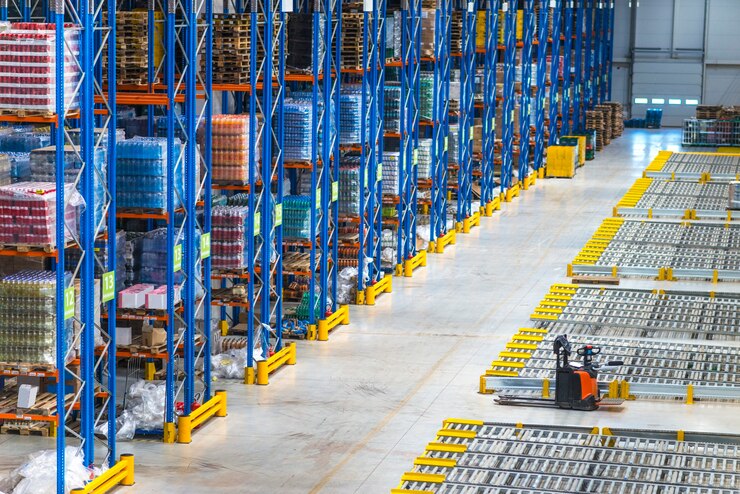Double Deep Pallet Racking System

The Double Deep Pallet Racking System is a high-density storage solution that allows for the storage of pallets back-to-back in each rack, effectively doubling the storage capacity compared to traditional selective pallet racking. This system is designed to maximize storage space in warehouses, particularly in environments where large volumes of similar goods need to be stored efficiently.
Description:
Double deep pallet racking utilizes standard selective pallet racking frames but with an extended depth, allowing pallets to be stored two deep in each lane. This means that each lane of racking can accommodate two pallets placed one behind the other, rather than just one pallet per lane.
Structure: The system is made up of upright frames and beams. The uprights are installed with a deeper depth to accommodate two rows of pallets. This is often coupled with specialized reach trucks or forklifts designed to reach the second row of pallets.
Forklift Requirements: Specialized equipment is required to handle double deep racks, as traditional forklifts may not have the reach necessary to access the rear pallets. Reach trucks or turret trucks are typically used, as they can extend into the rack and access both the front and rear pallets without moving the pallets themselves.
How It Works:
Storage:
- Pallets are loaded into the racking system, with each aisle storing two pallets per lane—one in front and one behind.
- A forklift or reach truck accesses the front pallet in a lane first. After retrieving or placing the first pallet, the forklift can then reach the second pallet in the lane.
Retrieval:
- The retrieval process is similar to storage but requires specialized equipment. The forklift first accesses the front pallet and then moves to the second pallet if required.
Stock Rotation:
- Double deep racking typically uses LIFO (Last In, First Out) stock rotation, as the newest pallets are stored at the back of the rack and retrieved first from the front.
Rack Configuration:
- This system can be configured in various ways depending on the available space and operational needs, and is often used in conjunction with other racking systems such as selective pallet racking.
Advantages:
Maximizes Storage Space:
- The primary benefit of the Double Deep Pallet Racking System is that it significantly increases storage capacity without expanding the footprint of the warehouse, making it ideal for maximizing available space.
Higher Density Storage:
- By storing two pallets in each lane, this system increases the density of storage, which is particularly useful in warehouses dealing with large volumes of goods that don't require frequent access.
Cost-Effective:
- Because it doubles the storage capacity, it provides a more cost-effective storage solution compared to traditional selective racking. It reduces the need for additional warehouse space or expansion.
Improved Space Utilization:
- The system allows for better utilization of the warehouse space by optimizing aisle width and rack height. This helps reduce aisle congestion and maximizes the storage volume.
Simplified Inventory Management:
- With fewer aisles and a more compact layout, inventory management and storage retrieval become more streamlined, especially in environments where pallets are uniform in size and similar in product type.
Increased Productivity:
- With efficient storage and retrieval processes, workers can access goods faster, improving warehouse operations and throughput.
Disadvantages:
Specialized Equipment Required:
- The system requires specialized forklifts, such as reach trucks or turret trucks, that can navigate the deeper rack configurations. This increases the initial cost of implementation and requires staff to be trained in operating these machines.
Reduced Access to Rear Pallets:
- The main disadvantage is that accessing the rear pallet in each lane can be cumbersome. Once the front pallet is removed, the rear pallet is often more difficult to reach without specialized equipment, and this can slow down retrieval times for less frequently accessed goods.
Limited Flexibility:
- This system is best suited for high-density storage of similar products. For warehouses that require fast access to a wide range of products, the double deep system may not be the most efficient choice.
Stock Rotation Issues:
- Double deep pallet racking is most suitable for LIFO (Last In, First Out) inventory management, which may not be ideal for all types of goods. Products that require FIFO (First In, First Out) stock rotation might face difficulties with this system.
Applications:
Food and Beverage Industry:
- For perishable goods that are high in volume but may not require frequent access, double deep pallet racking is ideal for reducing storage space while ensuring goods are accessible when needed.
Retail Warehouses:
- Retailers can use double deep pallet racking to store large quantities of similar goods, such as bulk items or products that are not regularly restocked.
Manufacturing:
- Manufacturing facilities can use double deep pallet racking to store raw materials or finished goods, particularly if the materials or goods are of the same type and stored in bulk.
E-commerce Warehouses:
- E-commerce fulfillment centers that handle large quantities of similar products benefit from the efficient use of space offered by double deep pallet racking, allowing for higher density storage while reducing aisle space.
Conclusion:
The Double Deep Pallet Racking System is a highly efficient storage solution that maximizes warehouse space and increases storage density. While it offers many advantages in terms of capacity and cost-effectiveness, it does require specialized equipment for accessing the rear pallets and may not be the best choice for warehouses that need frequent access to a variety of products. It is ideal for industries such as food and beverage, retail, and manufacturing where space optimization and high-density storage are key priorities.